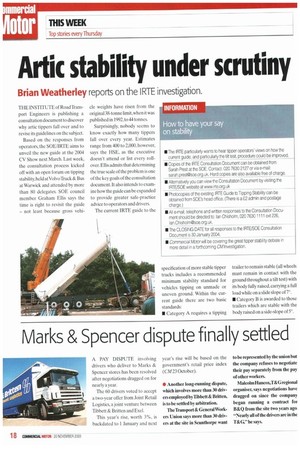Attic stability under scrutiny
Page 18

If you've noticed an error in this article please click here to report it so we can fix it.
Brian Weatherley reports on the IRTE investigation.
THE INSTITUTE of Road Transport Engineers is publishing a consultation document to discover why artic tippers fall over and to revise its guidelines on the subject.
Based on the responses from operators, the SOE/IRTE aims to unveil the new guide at the 2004 CV Show next March. Last week, the consultation process kicked off with an open forum on tipping stabili ty, held at Volvo Truck & Bus at Warwick and attended by more than 80 delegates. SOE council member Graham Ellis says the time is right to revisit the guide — not least because gross vehi cle weights have risen from the original 38-tonne limit, when it was published in 1992,to 44 tonnes.
Surprisingly, nobody seems to know exactly how many tippers fall over every year. Estimates range from 400 to 2,000. however, says the HSE, as the executive doesn't attend or list every rollover. Ellis admits that determining the true scale of the problem is one of the key goals of the consultation document. It also intends to examine how the guide can be expanded to provide greater safe-practice advice to operators and drivers.
The current IRTE guide to the specification of more stable tipper trucks includes a recommended minimum stability standard for vehicles tipping on unmade or uneven ground. Within the current guide there are two basic standards: • Category A requires a tipping trailer to remain stable (all wheels must remain in contact with the ground throughout a tilt test) with its body fully raised, canying a full load while on a slide slope of 7°.
• Category B is awarded to those trailers which are stable with the body raised on a side-slope of 5°.
































































































































































































